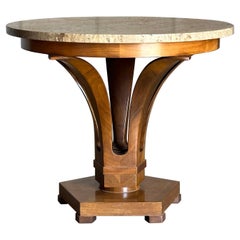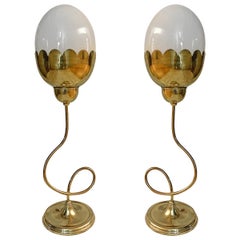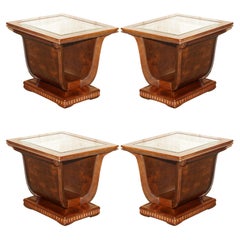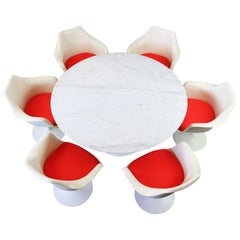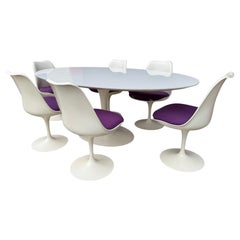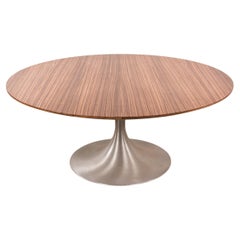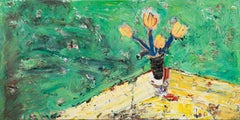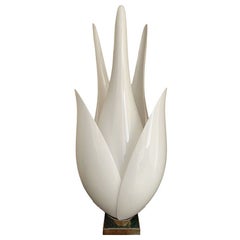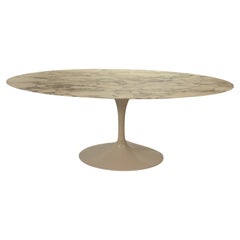Tulip Table Large
to
4
31
15
45
23
17
12
11
3
1
1
13
9
5
4
3
Sort By
Edward Wormley for Dunbar Large Tulip End/ Side Table in Travertine and Walnut
By Dunbar Furniture, Edward Wormley
Located in St.Petersburg, FL
A wonderful "Tulip" table designed by Edward Wormley for Dunbar, circa 1950s. Features a modern
Category
Vintage 1950s American Mid-Century Modern End Tables
Materials
Travertine
$4,900
H 22.75 in Dm 27 in
Set of Large Tulip Table Lamps with Glass Globes, Sold Per Pair
Located in New York, NY
Set of four circa 1960s oversized Italian tulip table lamps with milk glass globes. Sold per pair
Category
Vintage 1960s Table Lamps
Materials
Metal
FOUR LARGE TULIP SHAPED GLASS TOP ELM SiDE END TABLES WITH HIDDEN BASE STORAGE
Located in West Sussex, Pulborough
, Tulip shaped, bevelled glass topped, Burr Elm large side tables with hidden base storage
Please note
Category
20th Century European Mid-Century Modern End Tables
Materials
Glass, Elm
$4,402 Sale Price / set
20% Off
H 25.4 in W 30.12 in D 25.99 in
Knoll Tulip Dining Set by Eero Saarinen 1960s Large Marble Table Armchairs
By Knoll, Eero Saarinen
Located in Ijzendijke, NL
Magnificent fully original tulip dining set designed by Eero Saarinen and produced by Knoll
Category
Vintage 1960s American Mid-Century Modern Dining Room Sets
Materials
Carrara Marble, Aluminum
$15,006 / set
H 31.5 in W 25.2 in D 24.02 in
Eero Saarinen for Knoll Tulip Set Including Large Oval Table and 6 Chairs 1970s
By Eero Saarinen, Knoll
Located in Buffalo, NY
Eero Saarinen for Knoll Tulip Set Including Large 78" Oval Table and 6 tulip Chairs , c.1970s
Category
Vintage 1970s American Mid-Century Modern Dining Room Sets
Materials
Aluminum, Steel
$7,200
H 29 in W 78 in D 48 in
Large round coffee table with Tulip leg in brushed aluminum and Zebrano 1960.
Located in JOINVILLE-LE-PONT, FR
Superb coffee table in the style of Pierre Paulin or Eero Saarinen.
With its Tulip base and its
Category
Vintage 1960s French Scandinavian Modern Coffee and Cocktail Tables
Materials
Aluminum
$3,361 Sale Price
20% Off
H 19.3 in Dm 47.25 in
Large Tulips, Yellow Table
By Darius Yektai
Located in Sag Harbor, NY
Darius Yektai's "Large Tulips, Yellow Table" is a large-scale, multi-layered, oil on linen painting
Category
21st Century and Contemporary Contemporary Abstract Paintings
Materials
Oil, Linen
Large 3' Foot Grand Acrylic and Brass Floriform Tulip Lamp by Rougier
By Roger Rougier
Located in Van Nuys, CA
Large 35" tall grand "Tulip" lamp by Rougier with large hand-made white acrylic Floriform section
Category
Vintage 1970s Canadian Table Lamps
Materials
Acrylic
$1,170 Sale Price
40% Off
H 35 in W 14 in D 14 in
Eero Saarinen Oval Dinning Table for Knoll International, Swiss Production 1970s
By Knoll, Eero Saarinen
Located in Renens, CH
Oval-shaped large tulip dinning table designed by Eero Saarinen for Knoll International during the
Category
Vintage 1970s Swiss Mid-Century Modern Dining Room Tables
Materials
Aluminum
$10,324
H 28.35 in W 78.75 in D 47.64 in
Large Italian Murano Glass Table Lamp in Tulip Shape
Located in Los Angeles, CA
Large Italian Murano glass table lamp with 16 scroll details lining top rim in a translucent gold
Category
Late 20th Century Italian Mid-Century Modern Table Lamps
Materials
Brass
Large Tulip Arkana Dining Table
By Arkana Furniture, Maurice Burke
Located in Den Haag, NL
Large tulip Arkana dining table. Aluminum feet with a laminated top. Design by Maurice Burke for
Category
Vintage 1960s English Mid-Century Modern Dining Room Tables
Materials
Aluminum
Saarinen Large Oval Tulip Table
Located in San Francisco, CA
Rare larger oval marble dining/conferance table designed by Ero Saarinen for Knoll. Newly polished
Category
Vintage 1970s American Dining Room Tables
Materials
Marble
Very Large Tulip Style Dining Table
Located in Dallas, TX
Very large tulip style dining table, the chairs that are shown around the table are available in
Category
Mid-20th Century Dining Room Tables
Large Scale polished aluminum Tulip form table
Located in Danville, CA
A very large scale table consisting of four solid aluminum legs polished to a mirror finish
Category
Vintage 1970s Italian Center Tables
Materials
Aluminum
Pair of Rougier Large Tulip Table Lamps
By Roger Rougier
Located in Los Angeles, CA
Pair Of Rougier Large Tulip Table Lamps with Brass Accents on Base
The Tulip Petals & Base Are
Category
Vintage 1970s Canadian Mid-Century Modern Table Lamps
Materials
Brass
Edward Wormley for Dunbar Large Tulip Lamp Table
By Edward Wormley, Dunbar Furniture
Located in St.Petersburg, FL
An elegant and unusual lamp table by Edward Wormley for Dunbar. Ash pedestal, chrome petals, and
Category
Vintage 1960s American Mid-Century Modern Side Tables
Materials
Chrome
Large Round Tulip Dining Table With four Tulip Chairs Knoll Eero Saarinen
By Eero Saarinen
Located in Atlanta, GA
reduced it to the most effective structural solution. He designed the 1956 Tulip chair in terms of its
Category
Vintage 1970s American Mid-Century Modern Dining Room Sets
Materials
Steel
LARGE TULIP BASE BRASS TABLE ATTR. OSVALDO BORSANI
Located in Danville, CA
Four large brass curved legs joined at a Mahogany hub with beveled and smoked glass top
Category
Vintage 1970s Italian Dining Room Tables
Materials
Brass
Saarinen Knoll Large Dining Conference Table Pedestal - Tulip Collection
By Eero Saarinen
Located in Pasadena, TX
Original Saarinen design for Knoll, featuring revolutionary pedestal base introduced in 1958.
Heavy solid Dark Walnut top with knife edge, molded cast aluminum in black finish ov...
Category
Vintage 1950s American Conference Tables
Materials
Walnut
$6,900
H 28 in W 96 in D 54 in
Large Oval Marble Tulip Dining Table By Eero Saarinen
By Eero Saarinen, Knoll
Located in Brooklyn, NY
This iconic oval Tulip pedestal table dates to the 1960s and was designed by the famous Finnish
Category
Mid-20th Century American Mid-Century Modern Dining Room Tables
Materials
Marble, Composition
Large 1960s Arkana Tulip Dining Table by Maurice Burke
By Arkana Furniture, Maurice Burke
Located in Stow on the Wold, GB
A large 1960s tulip dining table designed by Maurice Burke and manufactured by Arkana, Bath, UK
Category
Mid-20th Century English Mid-Century Modern Dining Room Tables
Materials
Aluminum
Large 1960s Arkana Tulip Dining Table by Maurice Burke
By Arkana Furniture, Maurice Burke
Located in Stow on the Wold, GB
A large 1960s tulip dining table designed by Maurice Burke and manufactured by Arkana, Bath, UK
Category
Mid-20th Century English Mid-Century Modern Dining Room Tables
Materials
Aluminum
Pair of Mid Century Large Lucite "Tulip" Table Lamps
Located in Astoria, NY
This lovely pair of lucite table lamps is shaped like tulips and has matching lucite finials
Category
20th Century American Table Lamps
Materials
Metal
Large marble Tulip Dining Table by Eero Saarinen for Knoll
Located in New York, NY
Large and stunning tulip table by Saarinen. Beautifully varigated oval top, based in white with
Category
20th Century American Dining Room Tables
Materials
Marble
Large Midcentury Saarinen Style Tulip Table Burke Industries USA, 1970s
By Burke, Inc.
Located in West Hartford, CT
Large round midcentury white tulip table in the manner of Eero Saarinen. Features a white
Category
Vintage 1970s American Mid-Century Modern Dining Room Tables
Materials
Metal
Larger 1970s Rougier Floriform Tulip Lamps
By Roger Rougier
Located in Lake Worth, FL
Offering One Of Our Recent Palm Beach Estate Fine Lighting Acquisitions Of A
Pair of Larger 1970s
Category
Mid-20th Century Mid-Century Modern Table Lamps
Materials
Acrylic
Large Oval Marble Tulip Dining Table by Eero Saarinen for Knoll
Located in New York, NY
Large and stunning tulip table by Saarinen. Beautifully varigated oval top, based in white with
Category
Late 20th Century American Dining Room Tables
Materials
Marble, Steel
Large "Tulip Base Dining Table" with Glass Top by Karl Springer
Located in New York, NY
Large rectangular "Tulip Base Dining Table" in polished stainless steel and brass with glass top by
Category
Vintage 1970s American Dining Room Tables
Large Oval White Tulip Dining Table by Maurice Burke for Arkana
By Arkana Furniture
Located in Stow on the Wold, GB
A large Oval Tulip dining table designed by Maruice Burke and manufactured by Arkana, UK
Painted
Category
Mid-20th Century English Mid-Century Modern Dining Room Tables
Materials
Aluminum
$1,880
H 29.14 in W 42.52 in D 74.02 in
Large early 60" Eero Saarinen tulip table by Knoll with black base
By Eero Saarinen, Knoll
Located in Highland, IN
A spectacular example of an icon of modern design, this early production Saarinen tulip table has
Category
Vintage 1950s American Mid-Century Modern Dining Room Tables
Materials
Metal
Large tulip table with wooden top by Eero Saarinen, Knoll International 1970s
By Knoll, Eero Saarinen
Located in Antwerpen, VAN
Eero Saarinen’s Tulip Table, designed in 1956 as part of his Pedestal Collection for Knoll, was an
Category
Vintage 1970s American Space Age Dining Room Tables
Materials
Aluminum
$4,982
H 29.14 in Dm 53.94 in
Large Vintage Oval Walnut 'Tulip' Dining Table by Eero Saarinen for Knoll Studio
By Eero Saarinen, Knoll
Located in Highclere, Newbury
A large vintage wooden dining table with Walnut veneer and black ‘tulip’ base dating from the late
Category
Vintage 1980s Italian Mid-Century Modern Dining Room Tables
Materials
Carrara Marble, Aluminum
$5,502
H 29.14 in W 96.07 in D 53.94 in
1960s Extra Large Brass Tulip Table Lamp with One Glass Ball Space Age Pop Art
Located in München, DE
1960s extra large brass tulip table lamp with one glass ball. Great Space Age pop art design with a
Category
Vintage 1960s European Mid-Century Modern Table Lamps
Materials
Brass
$960
H 14.97 in Dm 9.85 in
Chrome and Oak Backgammon Table, 1960s, USA
Located in Los Angeles, CA
Beautiful oak and chrome backgammon table with a tulip base. Large Bakelite game pieces with
Category
Vintage 1960s American Game Tables
Materials
Chrome
Large Oval Marble Tulip Dining Table by Eero Saarinen for Knoll
By Eero Saarinen
Located in New York, NY
Large and stunning tulip table by Saarinen. Beautifully variegated white oval top with striations
Category
Vintage 1960s American Mid-Century Modern Dining Room Tables
Materials
Marble, Metal
Large Round Black Marble Top Tulip Base Saarinen for Knoll Dining Table
By Eero Saarinen, Knoll
Located in Rockaway, NJ
Mid-Century Modern Saarinen for Knoll round dining table. Like new condition. Measure: 48”.
Category
20th Century Italian Mid-Century Modern Dining Room Tables
Materials
Belgian Black Marble
1960s Large Scandinavian Tulip shaped Dining-Set / Complete Restored!
Located in Handewitt, DE
Scandinavian late 1960s dining-set. Tulip-shaped seating group consisting of 6 armchairs and a big
Category
Mid-20th Century Danish Scandinavian Modern Dining Room Sets
Materials
Metal
$13,086
H 0.4 in W 0.4 in D 0.4 in
Large Midcentury Sculptural Blossoming White Tulip Lamp by Roger Rougier
By Roger Rougier, Liane Rougier
Located in Ft. Lauderdale, FL
Designed by Roger Rougier and made by Liane Rougier this sculptural table lamp is a feast for the
Category
Mid-20th Century Canadian Mid-Century Modern Table Lamps
Materials
Brass
Mid-Century Black Marble Eero Saarinen Design Tulip Dining Table
By Knoll, Eero Saarinen
Located in Rio Vista, CA
Dramatic Mid-Century Modern tulip dining table featuring a large round black marble top with white
Category
Late 20th Century American Mid-Century Modern Dining Room Tables
Materials
Marble, Iron
Pair of Large Rougier Tulip Form Table Lamps
By Roger Rougier
Located in Keego Harbor, MI
Very large pair of Rougier tulip form table lamps.
Category
Vintage 1970s Canadian Mid-Century Modern Table Lamps
Large Eero Saarinen Tulip Dining Table with Original Custom Stone Top
By Eero Saarinen
Located in New York, NY
. This long tulip table was fabricated with a custom top and a base painted to match. The stone is
Category
20th Century American Mid-Century Modern Dining Room Tables
Materials
Stone, Metal
1970s Large Oval Arkana Rosewood and Aluminium Tulip Base Dining Table
By Maurice Burke, Arkana Furniture
Located in Kent, GB
This is a really magnificent piece of design by Maurice Burke for Arkana. The rosewood top has wonderful patina and marries beautifully with the sleek brushed aluminium base.
We a...
Category
Late 20th Century English Mid-Century Modern Dining Room Tables
Materials
Aluminum
$3,482
H 28.35 in W 72.84 in D 42.13 in
Large Table Lamp Italy 1970s Mid-Century Chrome Opalin Glass Steel tulip 20th
By Sergio Mazza
Located in L'Isle sur la Sorgue, FR
Table lamp high and large attributed to Sergio Mazza.
Italy.
1970s
Steel chrome and opalin.
Tulip
Category
Vintage 1960s Italian Mid-Century Modern Table Lamps
Materials
Steel, Chrome
$1,020
H 12.21 in Dm 12.21 in
Large Oval Tulip Dining Table in Grey Laminate by Eero Saarinen, circa1960
By Eero Saarinen, Knoll
Located in Paris, FR
Iconic model created by Eero Saarinen in 1956 and produced by Knoll.
In a very unusual version of laminate top with an onyx effect. Beautiful off-white varnished metal base.
The to...
Category
Vintage 1960s American Dining Room Tables
Materials
Metal
$5,402
H 28.75 in W 48.04 in D 77.96 in
Large Round 'Hollen' Tulip Table USA
By Hollen, Inc.
Located in Denver, CO
Vintage 54" round white laminate pedestal table designed and manufactured by
Hollen Inc, USA draws
Category
Vintage 1960s American Mid-Century Modern Dining Room Tables
Materials
Fiberglass, Laminate, Resin
Large Rougier Tulip Lamp
By Roger Rougier
Located in New York, NY
Large Rougier Tulip Lamp
Category
Mid-20th Century Canadian Mid-Century Modern Table Lamps
Get Updated with New Arrivals
Save "Tulip Table Large", and we’ll notify you when there are new listings in this category.
Tulip Table Large For Sale on 1stDibs
Choose from an assortment of styles, material and more with respect to the tulip table large you’re looking for at 1stDibs. Each tulip table large for sale was constructed with extraordinary care, often using metal, aluminum and marble. There are many kinds of the tulip table large you’re looking for, from those produced as long ago as the 20th Century to those made as recently as the 20th Century. A tulip table large, designed in the Mid-Century Modern style, is generally a popular piece of furniture. You’ll likely find more than one tulip table large that is appealing in its simplicity, but Eero Saarinen, Arkana Furniture and Knoll produced versions that are worth a look.
How Much is a Tulip Table Large?
A tulip table large can differ in price owing to various characteristics — the average selling price 1stDibs is $5,100, while the lowest priced sells for $983 and the highest can go for as much as $70,000.
Questions About Tulip Table Large
- What is a tulip table?1 Answer1stDibs ExpertApril 5, 2024A tulip table is a dining table or occasional table of a certain shape. It’s typically characterized by a slender stem-like pedestal base and a round tabletop. Its name is drawn from the name given to chairs that are part of a collection that Finnish-American designer and architect Eero Saarinen created for iconic mid-century furniture manufacturer Knoll during the 1950s.
The tables in Saarinen’s acclaimed series were called Pedestal tables, while the chairs were called Tulip chairs, armless or not, owing to their flower bulb-like shape. Today, design lovers everywhere frequently refer to Saarinen's Pedestal tables as tulip tables, and any table that looks like a Pedestal table is generally referred to as a tulip table, whether or not Saarinen had anything to do with it.
Find vintage Eero Saarinen tables on 1stDibs. - Why is it called a tulip table?1 Answer1stDibs ExpertMarch 22, 2022The Tulip table is called that because it matches the Tulip chair. With its tapered shape, the seat of the chair resembles a tulip flower. Eero Saarinen designed both the Tulip chair and the Tulip table. On 1stDibs, shop a collection of Tulip tables.
- What era are tulip tables from?1 Answer1stDibs ExpertMay 5, 2023Tulip tables are from the mid-century modern era. Finnish-American architect and furniture maker Eero Saarinen created the table in 1956 as part of the Pedestal collection of chairs and stools. The Pedestal table and its accompanying Tulip armchairs and armless chairs comprised cast-aluminum bases (“Tulip” became a common descriptor for all of the furnishings in the collection). Each table, stool and chair was crafted with a single, tapered cylindrical leg that descends to a base that flares into a circle, giving the illusion of being one piece. The series was designed for Knoll Inc. On 1stDibs, find vintage Tulip tables from some of the world’s top sellers.
- Are tulip tables sturdy?1 Answer1stDibs ExpertApril 5, 2022With a cast iron or aluminum alloy base, rest assured, the tulip table is indeed sturdy. With its centrally-placed leg, the style of the table was designed to be functional and structurally solid. You’ll find a variety of tulip tables from some of the world’s top sellers on 1stDibs.
- 1stDibs ExpertApril 5, 2022Eero Saarinen tulip tables are beloved by interior designers worldwide, and there are some key things to look for to ensure your table is authentic. Examine the base of the chairs and table and confirm they're made from one piece of cast aluminum with no visible seams. Tulip tables have been crafted from various materials over the years, but never plastic. You can also turn the table over to look for a Knoll Inc. tag, though some vintage tables may not have this. On 1stDibs, you'll find a collection of authentic Eero Saarinen tulip furniture from some of the world's top sellers.
- 1stDibs ExpertFebruary 13, 2023Many chairs can work with a Tulip table. The Tulip armchair, for example, was part of Eero Saarinen’s Pedestal collection of armless chairs, stools, Tulip side tables and more. The series, produced for Knoll, was a mid-century modernist exercise in simplifying, and Tulip chairs, with their curvy contours, match Tulip side tables and Pedestal dining tables very well. However, you can also try other mid-century modern chairs to see what works best in your space. Shop a collection of mid-century modern dining chairs on 1stDibs.
- 1stDibs ExpertOctober 7, 2024To tell a real Saarinen Tulip table, look under the tabletop. Authentic Saarinen tables will usually feature a label bearing the Knoll Industries name and a metal plaque that features Eero Saarinen's signature. The style of these tags and labels has changed over the years, but you can find pictures of them on the pages of trusted online resources to compare to the markings on your table. Materials can also be useful when authenticating Tulip tables. Authentic tables will have cast aluminum bases. A wood or plastic base is a good indication that the table is a replica, as is a plastic top rather than one made of wood, laminate or natural stone. If you're still unsure about the authenticity of your piece, a certified appraiser or knowledgeable antique dealer can assist you. Find a selection of Eero Saarinen Tulip tables on 1stDibs.
- 1stDibs ExpertApril 5, 2022Yes, the tulip table is considered a mid-century modern design. This table shape has become an iconic statement of the era with a simple sculptural attitude and a practical nature. The first tulip table was created by Eero Saarinen, a noted Finnish designer who was a leader in mid-century modern home decor. Shop a collection of Saarinen furniture from some of the world’s top sellers on 1stDibs.
- 1stDibs ExpertMarch 22, 2022Large dining tables are usually called banquet tables due to their ability to seat a crowd. Normally, banquet tables measure over 10 feet in length. Some standard dining tables convert to banquet tables with removable leaves. On 1stDibs, shop a variety of antique and vintage dining tables.
- 1stDibs ExpertApril 5, 2022What you put on top of a large coffee table really comes down to a matter of preference. Candles, books and decorative bowls are common design choices. You can shop a variety of coffee table goods from some of the world’s top sellers on 1stDibs.
More Ways To Browse
Christian Dior 2001
Hermes Kelly Beige
Vintage 70s Scarf
Aubergine Dress
Vintage Copper Belt
Bronze Justice Statue
Chinese Silver Goblet
Art Nouveau Spider
Hermes Palm Beach
Yves Saint Laurent 1971
Antique Justice Scale
Antique Justice Scales
Antique Open Salts
Antique Scales Of Justice
Antique Silver Nut Bowl
Bronze Canoe
Cabaret Tray
Chinese Multi Color Vase
